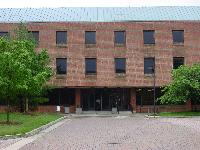
Site of Hypertext 2002 — University of Maryland Art-Sociology Building
College Park, Maryland, USA
June 11-15, 2002
by Lloyd Rutledge
This was a slow year for a good conference series. Hypertext has always been an INS2 favorite because of the conceptually intriguing mix of back-end hypertext system work and front-end hypertext art and literature application of these systems. This year remained interesting because many of the usual people were there to present their ongoing work and to stir up the usual assortment of interesting higher-level ideas to which we apply our work. However, submission and attendance rates were down this year, and this year's Hypertext did not have the gezelligheid and buzz of previous years.

Site of Hypertext 2002 — University of Maryland Art-Sociology Building
For the second year in a row, I was the lonely, sole representative of CWI-INS2 at Hypertext, a conference to which we once flocked in large, eager groups. This year was even lonelier than last year because many of our old favorite HT regulars were absent as well: no Wendy or Hugh, for example, and no Carole. My count of the registrant sheet was 84. The submission rate was lower than in previous years as well.
The general consensus is that not enough work went into organizing this year's Hypertext. In particular, there was very little publicity, which the chair Bob Allen confessed to himself during the welcoming talk. Key publicity events were noticeably absence, such as the lack of flyers as key conference in the year leading up to it. The Website for the conference itself suffered from the apparent lack of a professional designer. I've heard that no block of rooms in the suggested hotel was reserved, causing some unfortunates like myself who waited until mere days before the deadline to register and reserve ended up alone in hotels far away (more on this later). The poster holders has nothing arranged for them. They were allowed to post in the coffee area, but given nothing to post on. Paul de Bra managed to find a piece of hardboard somewhere, which he sat on a chair. A few others found cardboard boxes which they stood up as boxes and then taped papers along the side of it. In general, I felt the conference had kind of a neglected, uncozy feel to it.
On a more positive note, Hypertext has a good core crowd, and for the most part (though with a few notable exceptions), they were there. Hypertext is typically an interesting and engaging conference, and HT02 was as well, though not as much as the others. As expected, the presentations and panels shined through, as did discussions -- as should happen in any conference.
The full-day SMIL tutorial was lonely as well, though also with good participation. We had one pre-registration, and one who registered that day because another tutorial was cancelled due to low registration (mine wasn't cancelled for this reason because I agree to present no matter what). A third registration was a student volunteer who had the morning free. This attendance was probably (hopefully) more an indication of the popularity of the conference than of SMIL. One participant was Teresa Chambel, whom we've met at previous Hypertexts. She's a bit quite and unimposing, but asked really good (and very many) questions during the tutorial, and spun off some of the more interesting talks I've had at a SMIL tutorial.
The opening keynote was by Ed Ayers, a history professor at the University of Virginia. He discussed his hypertext project The Valley of the Shadow, which is a very interesting hypertext about the American Civil War. The talk itself was also very interesting. He is a lively and animated presenter, understands hypertext and the community, and understood the issues relating his work to the community.
The main sessions were held in the Art-Sociology building's main lecture hall and in a smaller classroom. I usually went to the panel tracks when they were given, resulting in my having seen several intriguing discussions, but very few paper presentations. The papers I did see included Paul de Bra's short paper on what's next for AHA!. Much of this wishlist involves semantics-like features. When pressed during coffee about why his XML notation for semantics and rules doesn't use RDF or OWL, his reply was "too many lines". Also in this adaptive hypertext session was Peter Brusilovsky's work on horizontal hypertext, whose discussion of linking between corresponding components on isomorphic but distinct trees got a best paper nomination.
Interestingly, the word "narrative" appears frequently in the program, giving it its own paper session. "Narratives and Literary Hypertext" The session included a paper by Polle Zellweger titled "Authoring Fluid Narrative Hypertexts Using Treetable Visualizations" about fluid clickable-to expandable inserts to the story's narrative thread. It was an interesting sort of "cheat" on the problem of maintaining coherent narrative in hyperlinking: there is still only one "backbone" narrative, about which all the user can control is how much gets filled in. Polle's closing speech was originally also going to be about "Using Technology to Support Narrative", but she changed the topic on the ride over to a more general overview of Hypertext interfaces. This session also had an interesting applied paper on the processing of rhetoric into narrative for safety documentation in the UK.
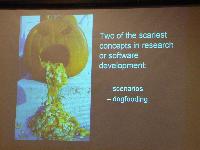
Slide by Cathy Marshall during panel
The first of the panel sessions I went to was on "Self-Assembling Hypertexts, Weblogs, and Wikis". This was a mostly technical discussion on the often very literary enterprise of maintaining heavily linked counter-postings. The panel "Chain Saws for Sculptural Hypertext" discussed Mark Bernstein's recently-introduced counterpoint to calligraphic hypertext — not the adding of links to an empty space but the selective removal of links from a fully-linked node space. The idea in its pure form is nonsense, but it does lead to interesting thoughts in the context of our work, in which a few nodes and links are selected and a few more links are generated from an archive of very many nodes and links. Like most Hypertext panel discussions, it produces some insights we may be able to use on a higher conceptual level, but not much to immediately work with.
Broader, more applicable and more structured was the "Seven Issues Revisited" panel. Each panelist gave their "non-issue" and a new issue. Then the audience voted the best out the the proposals for each category. The all-around winner was Rob Akscyn with the non-issue "What are the non-issues in Hypertext" and the new issue "How to make hypertext research economical applicable".
The panel most applicable to us, and the most frustrating, was the last one on multimedia. The panel was entirely in-club literati, with no multimedia systems people or anyone who has published in the multimedia track of hypertext. Being on the last day, it had five panelists and five members of the audience. There were some interesting examples put forth to the audience as "Is this multimedia"? (I a Webpage with complex layout and images multimedia?) Being high-brow literati who worked with nuts-and-bolts multimedia (flash, java), I missed hearing the viewpoint of structured research on multimedia — though I tried my best as humble audience member to present it. They defined multimedia from the user impact, which is of course the primary definition of anything. I discussed the systems-specific multimedia issues, such as the kinds of processing that are unique to multimedia (such as super-high processing and good generated graphics and sound), and thus cause certain computer environments to be called "multimedia" even if they don't seem that way to media artists (such as game-capable desktops).
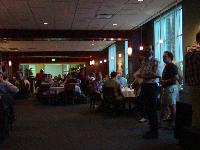
The conference dinner at Adele's
Socially, it was nice to catch up with the old crowd, and have some interesting off-line conversations. I chatted with Ethan Munson and Maria da Graša Campos Pimentel who are hosting upcoming conferences I am reviewing for &mdash respectively, Document Engineering and SBMIDIA &mdash The 8th Brazilian Symposium on Multimedia and Hypermedia Systems. Maria is an old HyTimer who visited for a few month at UMass-Lowell while I was doing my doctoral work there. She published her work on open semantic linking at this conference.
Of the Southampton crowd, I ran into Les Carr and David De Roure. David presented a short paper on musical hypertext. Les Carr did a stellar job of promoting Hypertext 2003.
I spoke quite a bit with Polle Zellweger, who has been surprisingly cast off from PARC. For those confused by the seemingly fractional name, insert the prefix "Formally known as Xerox ...". Like a lot of companies, Xerox decided it cannot continue to support research in these economically tumultuous times for Californian IT. Strange, since Xerox PARC was the most fiercely successful of industrial document research &mdash but then Xerox always did seem to miss capitalizing on it ... perhaps the reason why the research was so forward-reaching. Rather than properly close the lab off, Xerox decided to spin it off to its own entity &mdash following the logic of someone who can't bear to put his dear old dog to sleep, so instead he puts him loose in the woods to starve to death. Though in all fairness to Xerox, they justified the move saying that it made it either for another big company to buy it up.
So now PARC is in the strange new situation of having to generate its revenue from short-term projects with deliverables. The first move was for high-level managers to cut and slash where the resulting screams of agony seemed the least loud. Since Polle had just spent the year in Aarhus, and her department's head had already left, she was effectively a numb limb — no screams were heard when they chopped her off, and they won't notice the limb and profuse bleeding until later. This is a shame, since Polle does some great research. Serves as a warning about how fragile research existences can be, no matter how celebrated they are.
Perhaps the most encouraging part of the conference is seeing how well Hypertext 2003 is being publicized at this crucial early period. They not only had flyers out and a Website available for this precursor Hypertext, they had them out at last months WWW conference as well. Adam Moore gave a fun introduction warm-up Web presentation for the conference, and Les Carr have a good more detailed overall presentation of it. It looks like they've given thought for submission promotion as well as a good social atmosphere during the event itself, so it looks like next year could be a real pick-me-up year for the series.

The Biology-Psychology Building — typifying campus neo-classical architecture
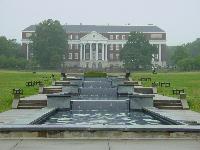
McKeldin Library and fountain
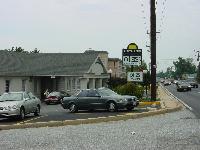
The Day's Inn in College Park
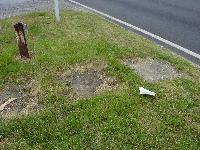
The strip has ghostly remnants of walkways to the street ... echoing a bygone era when people cared to walk to and on the street itself